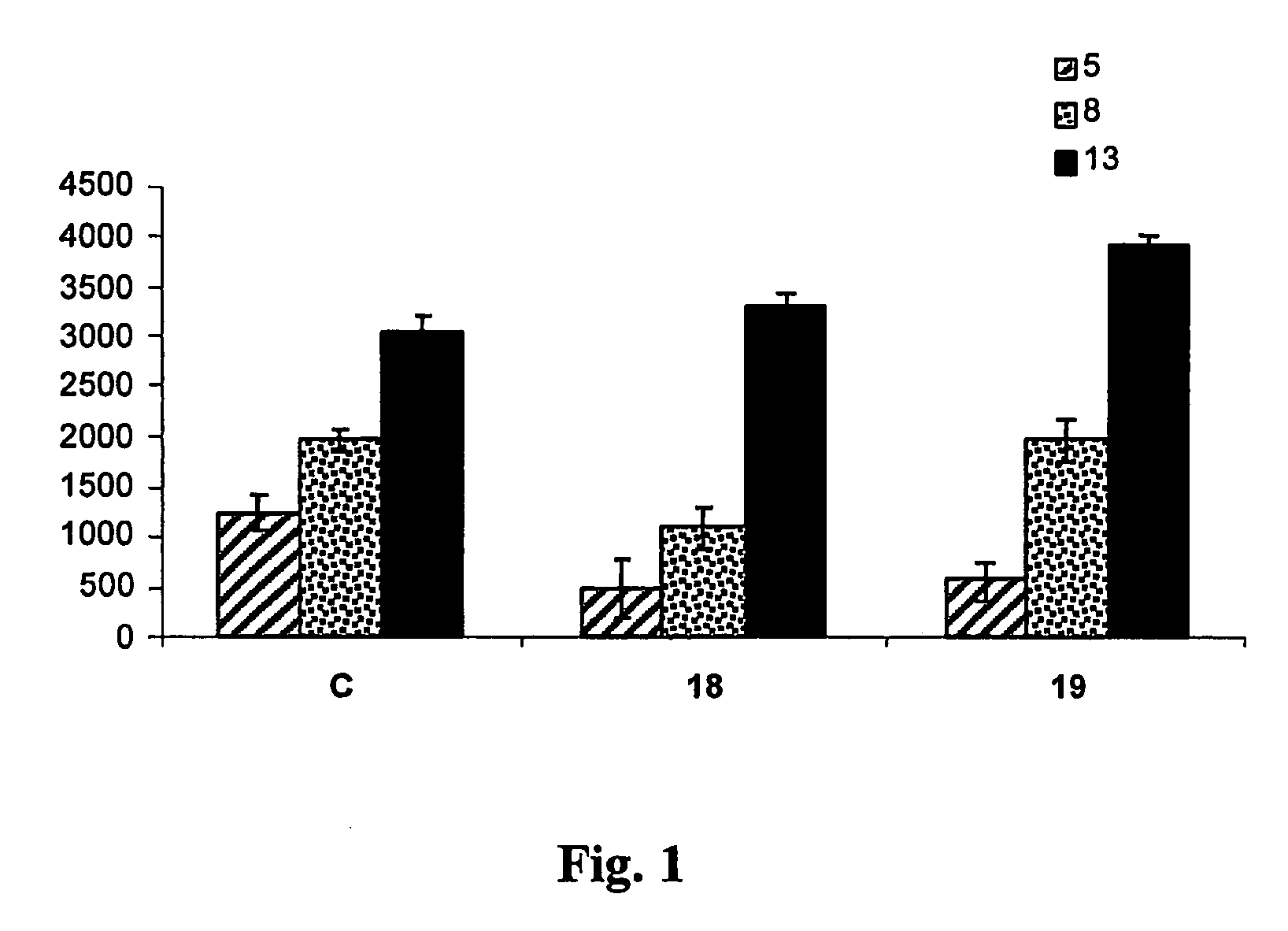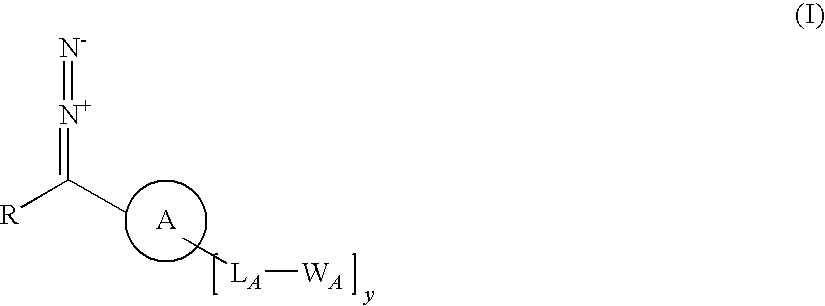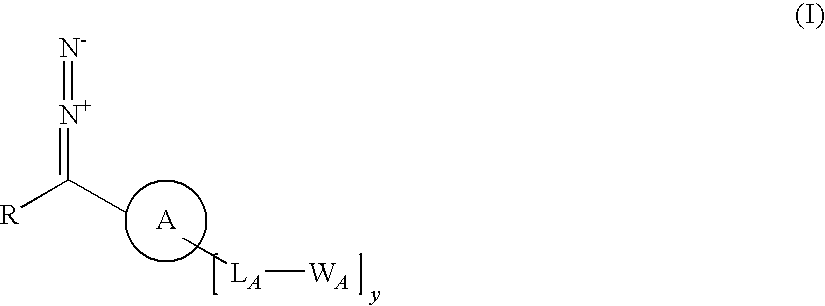Tailored control of surface properties by chemical modification
a technology of surface properties and chemical modification, applied in the direction of peptides, group 5/15 element organic compounds, enzymology, etc., can solve the problems of poor or less than desirable performance, high value-added plastic and polymeric materials can be expensive to produce, and compromise superior performance in one area, etc., to achieve significant economic and technical bulk advantages
- Summary
- Abstract
- Description
- Claims
- Application Information
AI Technical Summary
Benefits of technology
Problems solved by technology
Method used
Image
Examples
reference example 1
Preparation of 4-Bromomethyl benzophenone (2)
[0374]A stirred mixture of 4-methyl benzophenone (1) (15.0 g, 76 mmol) and N-bromo succinimide (14.2 g, 80 mmoll) in chloroform (100 ml) was heated to reflux for 18 h. with a 100W bulb shining 2 cm from the flask. The reaction mixture was cooled, washed with water and concentrated in vacuo. The resulting solid was washed with diethyl ether to leave 2 (15.1 g, 72%) as a white solid; δH (CDCl3) 4.55 (2H, s, CH2Br), 7.46-7.84 (9H, m, Ar—H).
reference example 2
Preparation of 4-Hydroxylmethyl benzophenone (3)
[0375]To a suspension of 2 (6.0 g, 22 mmol) in a mixture of 1,4 dioxane (60 ml) and water (60 ml) was added calcium carbonate (10.8 g, 110 mmol). The mixture was heated to reflux for 18 h, concentrated in vacuo and the residue portioned between DCM and water. The organic layer was collected, dried over MgSO4, concentrated in vacuo then recrystalised from diethyl ether to furnish 3 (4.1 g, 89%) as a white solid; M.P. 59-61° C. (Lit 61-64° C.); δH (CDCl3) 3.14 (s, 1H, CH2OH), 4.75 (s, 2H, CH2OH), 7.41-7.49 (m, 4H, 3-, 3′-, 5-, 5′-H), 7.54-7.58 (m, 1H, 4′-H), 7.72-7.76 (m, 4H, 2-, 2′-, 6-, 6′-H) ppm; δC (CDCl3) 64.4 (CH2OH), 126.4 (3′-, 5′-C), 128.3 (3-, 5-C), 130.0, 130.4 (2-, 2′-, 6-, 6′-C), 132.5 (4′-C), 136.4, 137.5 (1-, 1′-C), 140.0 (4-C), 196.9 (Ar2C═O) ppm; νmax (thin film) 3406, 3058, 2921, 1655, 1279 cm−1; m / z (ES) 211 ([M−H]− 100%), 183 (45%).
example 1
Preparation of [4-(Diazo(phenyl)methyl)phenyl]methanol (5)
4-Hydroxymethyl benzophenone hydrazone (4)
[0376]4-Bromomethyl benzophenone (2) was prepared as described in Reference Example 1. 4-Bromomethyl benzophenone (2) was converted into 4-Hydroxylmethyl benzophenone (3) as described in Reference Example 2. To solution of 3 (2.5 g, 12 mmol) in ethanol (20 ml) was added hydrazine hydrate (2.9 g 59 mmol). The mixture was heated to reflux for 24 h. then concentrated in vacuo. The residue was portioned between DCM and water and the organic layer collected and concentrated to yield 4 (2.6 g, 98%) a mixture of cis and trans isomers and as a yellow semi solid; δH (CDCl3) 2.84, 3.09 (2×bs, 1H, OH), 4.51, 4.61 (2×s, 2H, CH2OH), 5.32 (bs, 2H, NNH2), 7.13-7.17 (m, 4H, 3-, 3′-, 5-, 5′-H), 7.30-7.43 (m, 5H, 2-, 2′-, 4′-, 6-, 6′-H) ppm; δC (CDCl3) 64.4, 64.6 (2×CH2OH), 126.4, 126.6, 127.7, 128.0, 128.1, 128.6, 128.8, 128.9, 129.3 (Ar—C), 131.8, 132.7 (2×1′-C), 137.5, 138.2 (2×1-C), 141.0, 141.8 (2...
PUM
| Property | Measurement | Unit |
|---|---|---|
| diameter | aaaaa | aaaaa |
| diameter | aaaaa | aaaaa |
| diameter | aaaaa | aaaaa |
Abstract
Description
Claims
Application Information
 Login to View More
Login to View More - R&D
- Intellectual Property
- Life Sciences
- Materials
- Tech Scout
- Unparalleled Data Quality
- Higher Quality Content
- 60% Fewer Hallucinations
Browse by: Latest US Patents, China's latest patents, Technical Efficacy Thesaurus, Application Domain, Technology Topic, Popular Technical Reports.
© 2025 PatSnap. All rights reserved.Legal|Privacy policy|Modern Slavery Act Transparency Statement|Sitemap|About US| Contact US: help@patsnap.com



